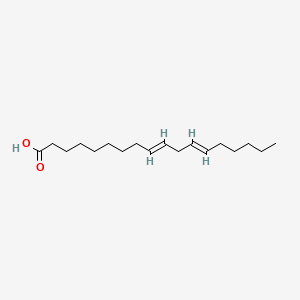| MeSH term | MeSH ID | Detail |
|---|---|---|
| Hypersensitivity, Immediate | D006969 | 14 associated lipids |
| Alopecia | D000505 | 14 associated lipids |
| Polycystic Ovary Syndrome | D011085 | 14 associated lipids |
| Respiratory Distress Syndrome, Adult | D012128 | 15 associated lipids |
| Tremor | D014202 | 15 associated lipids |
| Demyelinating Diseases | D003711 | 15 associated lipids |
| Hyperlipoproteinemias | D006951 | 15 associated lipids |
| Alcoholic Intoxication | D000435 | 15 associated lipids |
| Pulmonary Disease, Chronic Obstructive | D029424 | 16 associated lipids |
| Diabetic Ketoacidosis | D016883 | 16 associated lipids |
Linoelaidic acid
Linoelaidic acid is a lipid of Fatty Acyls (FA) class. Linoelaidic acid is associated with abnormalities such as Obesity, Diabetes Mellitus, Non-Insulin-Dependent, Pneumonia, Chronic Obstructive Airway Disease and Metabolic syndrome. The involved functions are known as Metabolic Inhibition, Steroid biosynthesis, Signal Transduction, Insulin Resistance and Inflammation. Linoelaidic acid often locates in Mitochondria, Membrane and Cytoplasmic matrix. The associated genes with Linoelaidic acid are FFAR1 gene, C9orf7 gene, TNF gene, CCL2 gene and TLR4 gene. The related lipids are Fatty Acids, octadecadienoic acid, Steroids, methyl linoleate and Cyanoketone.
Cross Reference
Introduction
To understand associated biological information of Linoelaidic acid, we collected biological information of abnormalities, associated pathways, cellular/molecular locations, biological functions, related genes/proteins, lipids and common seen animal/experimental models with organized paragraphs from literatures.
What diseases are associated with Linoelaidic acid?
Linoelaidic acid is suspected in Obesity, Diabetes Mellitus, Non-Insulin-Dependent, Pneumonia, Chronic Obstructive Airway Disease, Metabolic syndrome and other diseases in descending order of the highest number of associated sentences.
Related references are mostly published in these journals:
| Disease | Cross reference | Weighted score | Related literature |
|---|
Possible diseases from mapped MeSH terms on references
We collected disease MeSH terms mapped to the references associated with Linoelaidic acid
PubChem Associated disorders and diseases
What pathways are associated with Linoelaidic acid
There are no associated biomedical information in the current reference collection.
PubChem Biomolecular Interactions and Pathways
Link to PubChem Biomolecular Interactions and PathwaysWhat cellular locations are associated with Linoelaidic acid?
Visualization in cellular structure
Associated locations are in red color. Not associated locations are in black.
Related references are published most in these journals:
| Location | Cross reference | Weighted score | Related literatures |
|---|
What functions are associated with Linoelaidic acid?
Related references are published most in these journals:
| Function | Cross reference | Weighted score | Related literatures |
|---|
What lipids are associated with Linoelaidic acid?
Related references are published most in these journals:
| Lipid concept | Cross reference | Weighted score | Related literatures |
|---|
What genes are associated with Linoelaidic acid?
Related references are published most in these journals:
- Prostaglandins Leukot. Essent. Fatty Acids (1)
- Thorax (1)
- Am. J. Physiol., Cell Physiol. (1)
- Others (1)
| Gene | Cross reference | Weighted score | Related literatures |
|---|
What common seen animal models are associated with Linoelaidic acid?
There are no associated biomedical information in the current reference collection.
NCBI Entrez Crosslinks
All references with Linoelaidic acid
Download all related citations| Authors | Title | Published | Journal | PubMed Link |
|---|---|---|---|---|
| Petrogianni M et al. | Additional benefit in CVD risk indices derived from the consumption of fortified milk when combined with a lifestyle intervention. | 2014 | Public Health Nutr | pmid:23249766 |
| Huang X et al. | Serum and adipose tissue fatty acid composition as biomarkers of habitual dietary fat intake in elderly men with chronic kidney disease. | 2014 | Nephrol. Dial. Transplant. | pmid:23229929 |
| Shimamoto C et al. | Functional characterization of FABP3, 5 and 7 gene variants identified in schizophrenia and autism spectrum disorder and mouse behavioral studies. | 2014 | Hum. Mol. Genet. | pmid:25027319 |
| Hellstrand S et al. | Genetic variation in FADS1 has little effect on the association between dietary PUFA intake and cardiovascular disease. | 2014 | J. Nutr. | pmid:25008580 |
| Hester AG et al. | Relationship between a common variant in the fatty acid desaturase (FADS) cluster and eicosanoid generation in humans. | 2014 | J. Biol. Chem. | pmid:24962583 |
| Nadtochiy SM et al. | Mitochondrially targeted nitro-linoleate: a new tool for the study of cardioprotection. | 2014 | Br. J. Pharmacol. | pmid:24102583 |
| Huang X et al. | Serum fatty acid patterns, insulin sensitivity and the metabolic syndrome in individuals with chronic kidney disease. | 2014 | J. Intern. Med. | pmid:24011327 |
| López A et al. | Compressive mechanical properties and cytocompatibility of bone-compliant, linoleic acid-modified bone cement in a bovine model. | 2014 | J Mech Behav Biomed Mater | pmid:24508711 |
| Ozdener MH et al. | CD36- and GPR120-mediated Ca²⺠signaling in human taste bud cells mediates differential responses to fatty acids and is altered in obese mice. | 2014 | Gastroenterology | pmid:24412488 |
| Hoffman LC et al. | Lipid and protein stability and sensory evaluation of ostrich (Struthio camelus) droëwors with the addition of rooibos tea extract (Aspalathus linearis) as a natural antioxidant. | 2014 | Meat Sci. | pmid:24334052 |
